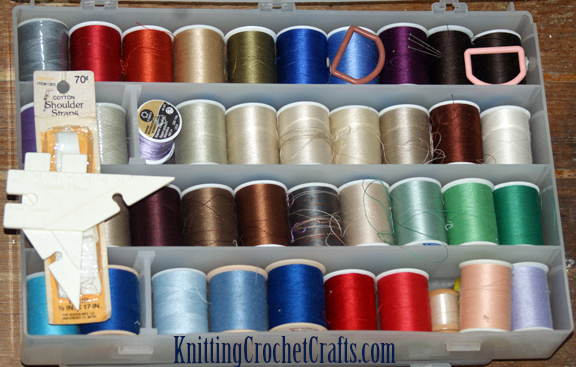Sewing thread is a long, thin, continuous cord that is typically packaged on spools; you can purchase individual spools of thread, bulk packs of thread or sewing kits that include thread plus other supplies — usually including needles and perhaps some additional supplies such as a needle threader, thimble, scissors, tape measure or pincushion. Various sewing threads can be used for hand sewing, machine sewing, hand embroidery, machine embroidery, hand quilting or machine quilting. You’d want to choose a thread that’s specifically suited for the type of craft project you’re planning to do.
Sewing thread can be made from a variety of fibers. Some of the most popular sewing threads are cotton, polyester and poly/cotton. Other possibilities include wool thread, silk thread, linen thread, rayon thread, nylon thread and metallic thread, which is typically made from one or more synthetic fibers.
When you’re not sure which thread to choose for your project, you usually can’t go wrong by matching the fiber contents of your thread to the fiber contents of your project. See below for more info on how to know which type of thread you’d want to choose for each type of craft technique.
Sewing Thread Colors
Sewing thread is available in a broad variety of colors. These include both solids and variegated colors (meaning that the thread has color variations). There are lustrous, matte and metallic thread colors available.
Serger Thread
Serger thread is typically sold on cones or spools and is available in a broad variety of fibers.
Cotton Sewing Thread
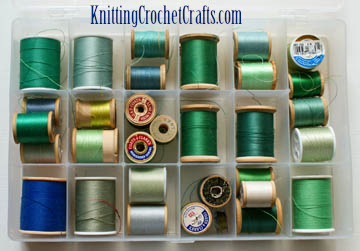
Vintage Spools of Cotton Sewing Thread and Other Sewing Thread in a Craft Organizer
Cotton sewing thread is easy to use and care for. It isn’t the strongest fiber available, but it does tend to be durable and long-lasting. Unless stated otherwise on the label, cotton sewing thread is generally machine washable, hand washable and dry cleanable.
100% cotton thread is what you want to choose if you will be quilting or sewing with cotton fabric. You want to avoid using polyester thread for quilting or sewing on cotton, because, in the long term, polyester thread could potentially damage your cotton and need to be mended. This can happen because polyester tends to be a stronger fiber than cotton — and in cases Where a particular thread is significantly stronger than the fabric that is sewn with it, the fabric is likely to tear before the thread breaks. It is preferable to use a thread that is slightly weaker than the fabric, so that when stress occurs, the seam will tear but the fabric will remain intact. This makes the task of mending much easier.
For hand quilting, you’d ideally want to choose a dedicated hand quilting thread, which has a wax coating on it that is referred to as a “glaze”. The glaze makes it easier for you to stitch through multiple layers of fabric; it decreases the friction that develops between the thread and the fabric, making for a smoother trip for your thread through the fabric. The coating also minimizes the thread lint and helps to make the thread somewhat more resistant to breaking. For machine quilting, you’d want to avoid choosing hand quilting threads, because the thread coating isn’t compatible with sewing machines.
Organic Cotton Sewing Thread
I recommend buying organic cotton sewing thread whenever possible, because it is much better for the environment than thread made from conventionally-grown cotton is. This is because organic cotton uses far less water and far fewer toxic pesticides than conventionally-grown cotton does.
Mercerized Cotton Sewing Thread
Mercerized cotton is cotton that has been subjected to the mercerization process. This process typically results in a strong finished product that has a lustrous sheen.
Polyester Sewing Thread
Polyester is a synthetic material which is typically stronger than cotton. It tends to be a stretchy fiber; polyester thread is ideal for use with projects where it’s OK for the thread to have a bit of “give”. Polyester typically does not shed much or any lint. It can be smooth or texturized. A fine, transparent polyester thread is available which can be useful for machine quilting projects — although I personally prefer to use cotton thread for quilting projects.
Poly/Cotton Sewing Thread
Some manufacturers offer a poly-cotton thread where the polyester component is a core that’s encased in cotton. This results in a thread that’s a bit stretchy, and is stronger than cotton overall, but it looks like cotton. If you’re quilting, this type of thread is generally preferable to using 100 percent polyester thread, but my opinion is that 100 percent cotton thread is still better-suited to quilting projects or any sewing projects made from 100 percent cotton fabric.
Metallic Sewing Thread
Metallic sewing thread typically has a core of polyester or nylon that’s surrounded by a delicate metallic outer layer. There may be another protective outer coating overtop of the metallic layer.
Be sure to check care instructions on metallic sewing thread, because this type of thread may have special care requirements you’ll need to attend to.
Silk Sewing Thread
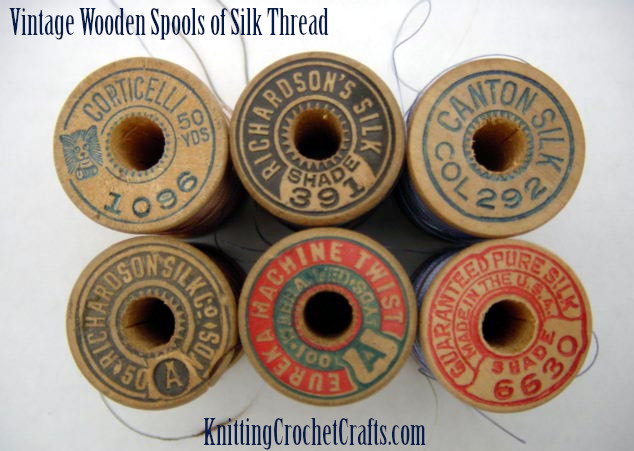
Vintage Wooden Spools of Silk Thread
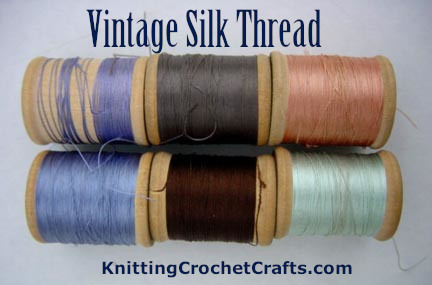
Small Vintage Wooden Spools of Silk Thread
Silk sewing thread is beautiful, strong and appealing. It is particularly lovely to use for hand embroidery projects; some of the most impressive vintage linens you find in antique shops were made using silk threads to embroider motifs onto the cloth. It is also recommended to use for machine embroidering appliques or beading on fabric.
Silk thread is a specialty item, and it can be hard to find; you’re unlikely to find it at your local big box store, so your best bet is to shop for it online. Because silk thread was popular in bygone times, it is sometimes possible to find vintage silk threads available for sale in antique stores and thrift shops. Some now-defunct, former manufacturers of silk thread include the Nonotuck Silk Company, the Corticelli Silk Company, the Brainerd and Armstrong Company, and Richardson Silk Company. If you’re buying silk thread on the secondary market, you have to be aware that older silk thread is likely to be fragile, because silk thread is vulnerable to degrading with time.
Be sure to check care instructions on silk sewing thread, since this type of thread is likely to have special care requirements to be aware of.
Rayon Thread
Rayon is a synthetic fiber that is derived from cellulose. Rayon thread is useful for sewing projects made from rayon fabric, and also for decorative machine embroidery. Rayon thread is not recommended for completing the stitching on patchwork quilting projects.
Rayon fibers tend to become excessively weak when they get wet, and they become susceptible to tearing. For that reason, many manufacturers of rayon fibers recommend dry cleaning them rather than machine or hand washing them in water. Unless the manufacturer of your rayon thread specifically recommends machine washing or hand washing, it’s best to assume that you will probably need to dry clean the projects you create using rayon thread. This will maximize the amount of wear you’ll get from your projects.
Nylon Thread
Nylon is a synthetic fiber that can be made into transparent or colored monofilament thread. It is possible to use this type of thread for machine quilting, however, it has multiple downsides when used for this purpose. With time, it will wear differently than the cotton fibers that quilters typically use; so it isn’t ideal for use in any quilting project that you want to keep in the long term. The nylon thread is likely to become brittle with age, and it may melt if subjected to high heat from an iron or clothes dryer.
Wool Sewing Thread
Wool can be spun into a variety of threads and yarns that are useful for sewing and other needlework products.
Follow the care instructions on your thread label carefully in order to maximize the lifespan of your project. Wool threads and yarns are not generally machine washable unless they have been subjected to a “superwash” treatment. In any case, your project made with wool thread is not likely to be machine dryable unless the label specifically states otherwise.
Fusible Thread
Fusible thread isn’t what you want for actually making the permanent seam in your sewing or quilting projects. You’d want to choose fusible thread in some situations where you need a temporary bond instead of a permanent stitch. It’s most useful for holding fabric pieces in the spot you want them while you are working on stitching them together permanently.
You could use fusible thread in situations where you’d ordinarily pin or glue your fabric pieces together. For example, it can be useful for stitching hems in place, sewing quilt bindings, fusing basting stitches, and for holding your appliques in place while you secure them. In any situation where you would find it useful to have your seams temporarily fused together, you could use a fusible thread to accomplish this task.
Fusible thread is typically made from a “meltable” synthetic fiber such as nylon or polyester/nylon blends — and it is specifically intended to melt or temporarily fuse together when you press it with an iron, dry it in the clothes dryer or otherwise heat it.
Popular Brands of Sewing Thread
- Coats & Clark; Coats Outdoor
- Gutermann
- Maderia
- Metrosene
- Mettler
- Robison Anton
- Signature
- Sulky; Crossroads by Amy Barickman
- Superior
- Valdani
- YLI
So there you have it: That’s a basic introduction to sewing thread. Of course, there is much more to learn about thread — and if you spend any significant amount of time sewing, quilting or doing embroidery, you are likely to gain more expertise just by using thread and developing your own preferences for various brands and types of thread.
More Crafts, Hobbies and DIY Projects:
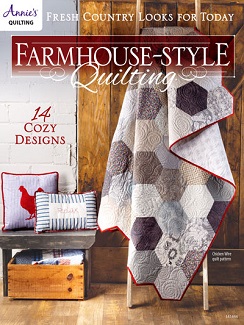
Farmhouse-Style Quilting Book: 14 Spectacular Quilt Patterns You Will LOVE If the Farmhouse Style Appeals to You
- Learn How to Do Wire Crochet With Beads
- Craft Supplies
- Knitting
- Knitting Supplies
- Lace Knitting
- Cable Knitting
- Knitting Techniques
- Knitting Yarn
- Quilting
- Jewelry Making
- Best Tools for Jewelry Making
- Beadwork
- Sewing
- Sewing Appliques
- Button Crafts
- Kitchen Crafts
- Home Decor Crafts and DIY Project Ideas
- Holiday Crafts
- Christmas Crafts
- Paper Crafts
- Fine Art
Find More Craft Project Ideas HERE!
Posted By: Amy Solovay
This page was last updated on 7-6-2023.
